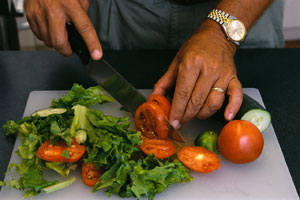Nutrition Unit Plan
for Sixth Graders


|
|
|
| Introduction | Lesson 1 | Lesson 2 | Lesson 3 | Lesson 4 | ||||||||||||||||||||||||||||||||||||||||||
|
Lesson Goal: Students will define common terms found on most food labels. Students will demonstrate the ability to determine the nutritional merits of a food product by analyzing the food label. Time Frame: Three 60-minute class periods Objectives: · Students will state the definition and function of nutrients. · Students will state the definition and function of calories · Students will state the definition and function of carbohydrates. · Students will state the definition and function of protein. · Students will state the definition and function of fats. · Students will distinguish the differences between saturated fats and trans fats. · Students will state the definition and function of cholesterol. · Students will distinguish the differences between the two types of cholesterol. · Students will state the definition and function of sodium. · Students will state the definition and function of dietary fiber. · Students will state the definition and function of Vitamin A. · Students will state the definition and function of Vitamin C. · Students will state the definition and function of Iron. · Students will apply the “serving size” information on the food label to actual portions. · Students will use the % daily values to see if a food has a little or a lot of a nutrient. Materials: The Complete Idiot’s Guide to Looking Good for
Teens Nutrition For Dummies Eat, Play and Be Healthy Rubric for Power Point Evaluation I. Making the Connection *The information will be recorded on a blackboard or flip chart by a
teacher assistant if available or a student scribe. a. The instructor will move into soliciting ideas about the things that the human body needs to stay healthy. Why is it said, “We are what we eat?” Again, the responses will be recorded by scribe. b.
c.
c. Students will pair up and be given 20 minutes to explore
this website, “Under the Microscope” with the objective of becoming
familiar with the definitions of different components of a food label. d. d. The teacher will bring the group back together and facilitate a large group discussion on interpreting a sample nutrition label for macaroni & cheese: 1.) applying the serving size information to actual portions and 2.) analyzing % daily values to see if a food has a little or a lot of a nutrient. e. e. The teacher will break the class into six groups. Each group will collect and synthesize information in order to gain an in-depth understanding of one category of nutrient and become an “expert” on that nutrient. f. f. Each group will relay their findings through a PowerPoint presentation, followed by class discussion. Within the class discussion re-analyze the macaroni & cheese label to discover new insights.
Assessment: Rubric for PowerPoint
Presentation
|
||||||||||||||||||||||||||||||||||||||||||||||
|
The views and opinions
expressed in this page are strictly those of the page author. |
||||||||||||||||||||||||||||||||||||||||||||||